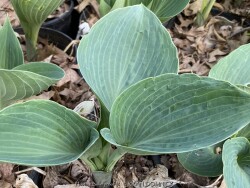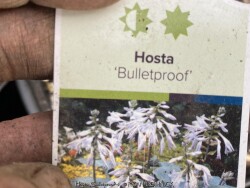

Plant Min Zone: 3a
Plant Max Zone: 8b
Sunlight: Part Sun, Shade, Deep Shade
Water / Rainfall: Average, High
Soil Quality: Average, Rich
Bloom Season: Summer
Flower Color: White
Berry / Fruit Color: None
Spring Foliage Color: Bluish Green
Summer Foliage Color: Bluish Green
Fall Foliage Color: Gold, Yellow
Evergreen Foliage: No
Winter Interest: No
Scented Flowers: No
Drought Tolerance: Low, Medium
Wet-Feet Tolerance: Medium
Humidity Tolerance: Medium
Wind Tolerance: Low
Poor Soil Tolerance: Clay Soils
Height: 1' - 2'
Width: 2' - 3'
Growth Rate: Medium
Service Life: Very Long: 10-20 years
Maintenance Need: Low
Spreading Potential: Low
Yearly Trimming Tips: Trim Perennial to Ground Around First Fall Freeze: No Winter Interest.
Plant Grouping Size: Small Grouping of 3-5, Medium Grouping of 5-10, Mass Planting of 10 or more
Best Side of House: East Exposure, North Exposure
Extreme Planting Locations: Base of Retaining Wall Locations
Ornamental Features: Multiple Seasons of Interest, Long Blooming Season, Large Tropical Foliage / Flowers, Exceptional / Colorful Foliage
Special Landscape Uses: Groundcover
Possible Pest Problems: Deer, Rabbits, Virus
Plant Limitations: Needs Regular Irrigation
Shippable in 2026: YES
Hosta by far is the most popular and well-known shade plant in the United States. Many thousands of cultivars exist from original species native to China, Japan, and other forested areas in Asia. Hosta foliage arrises from a clump-forming root system and is often large and dramatic with many types of variegation. Flowers, born on tall stocks ranging in shades of white and purple, are equally attractive. Hostas grow best in rich, well-drained soils in full to partial shade. In Eastern Kansas with our average 40 inches of average rainfall, plants are drought tolerant if established in moisture-retentive high-quality soil. Dry-shade areas are best avoided. Afternoon sun with temperatures over 95 degrees F but likely burn the tips of hosta foliage rendering them unattractive for the rest of the year. There is no secondary growth by late summer after flowering and after buds have been set for next year. In northern parts of the country, hostas can handle full sun. In the Southern part of their range further South than zone 7, hosta can really struggle through the long summer heat unless conditions are perfect. Rabbits, deer, slugs, and snails can be a problem generally on small or un-established plants. Large-leaf robust varieties seem to outgrow browsing predators better than small dainty varieties. Methods of control are effective ranging from cages to deer repellents. Generally, a large established planting of hostas will be there for decades gradually getting thicker and denser without a need to divide. Many plantings have been in our display garden for 15-20 years with no weeds ever trying to grow in the shade of the foliage. Hosta foliage is susceptible to late spring freezes so try to cover if possible. During the Easter freeze of April, 2007, thousands of hosta were killed to the ground in eastern Kansas but all returned successfully by May from secondary buds. Hosta's newly unfurling foliage is considered edible when cooked like asparagus or eaten raw in salads. Hosta 'Bulletproof' has extremely thick blue leaves that look good all season: very resistant to slugs and snails. Sport of 'Halcyon'